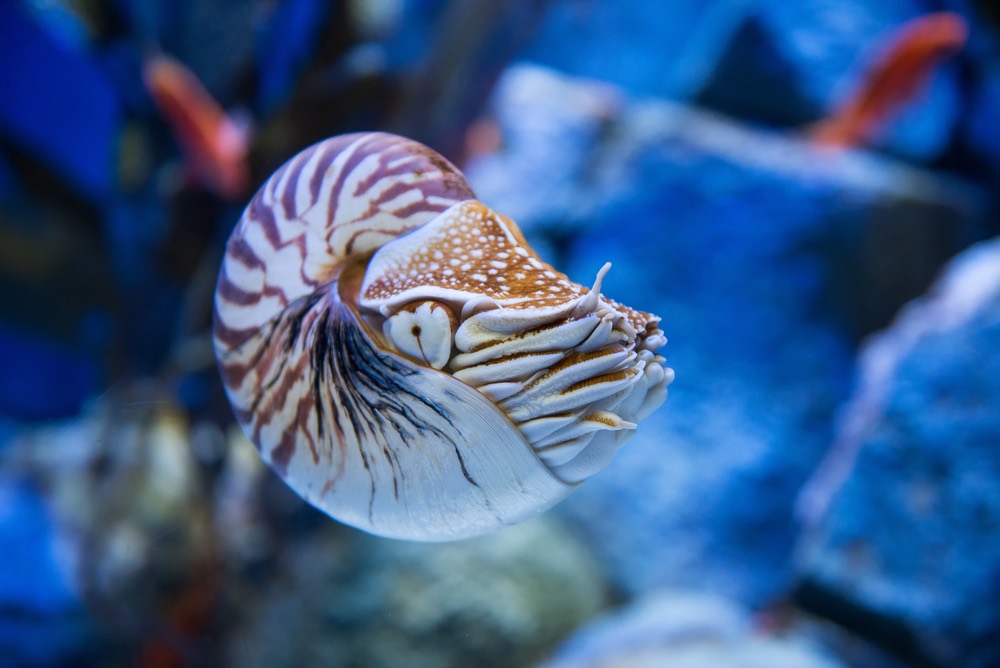Animal Sex: How Nautiluses Do It

Nautiluses are physically distinct among cephalopods — the family of marine mollusks that also includes octopuses, squid and cuttlefish — in that their squishy bodies are protected by a hard, spiraled, fully developed shell. But are the mating behaviors of these ancient animals just as unique as their appearance?
Today, there are six living species of nautiluses across two genera, all of which are found in Indo-Pacific waters near the ocean bottom or alongside deep-sea corals. "That's the tricky part to studying them," said Gregory Barord, a marine biologist with the conservation organization Save the Nautilus. "Most of our understanding of nautiluses is based on captive observations because they normally live [at depths of] four-five-six hundred meters."
With that said, Barord added, it appears that nautiluses don't have specific mating seasons. Rather, similar to humans, they can mate at any time of the year after they reach sexual maturity at typically 10 to 12 years old, he told Live Science. [In Photos: Strange Purple Orb Found in Pacific Ocean]
Underwater camera recordings suggest that nautiluses are relatively solitary creatures and not found in groups in their natural habitat, unless they're feeding or mating. In fact, "females are kind of repelled by other females," Barord said.
Driven by scent
Often called "living fossils" because they've survived relatively unchanged for hundreds of millions of years, nautiluses have "primitive" eyes, among other things. But, Barord noted, they have the largest olfactory organs among cephalopods and likely use their powerful sense of smell to find food and potential mates.
Nautiluses are opportunistic feeders and baited-camera research appears to suggest the animal's sense of smell is highly tuned. But once the mollusks congregate on to the bait, they try to mate with each other. [In Photos: See an Octopus Cannibal in Action]
"The weird thing about them is that whenever you get them together, they mate or at least try to mate," Barord said. This eagerness may suggest that mating opportunities in the wild are difficult to come by.
Get the world’s most fascinating discoveries delivered straight to your inbox.
Numerous studies have reported an odd observation about nautilus populations: Males vastly outnumber females, which appear to make up just 20 to 30 percent of populations. But sampling techniques may be to blame — since the animas live so deep, researchers often base their population estimates of nautiluses on trap rates. Female nautiluses appear to avoid other females (based on laboratory studies), so it may just be the case that they stay away from baited traps when they smell other females around, Barord suggested.
Whatever the case, it's not unheard of for a mature female to be hounded by more than one male at a time. In some cases, four nautiluses will be "attached" to one another as they try to mate, but it's unclear what kind of competition is occurring between the males. "It's hard to say what is going on," Barord said. "Are they are all transferring spermatophores [sperm packets] or are they trying to push the first male away?"
What does seem clear, however, is that unlike other cephalopods, which are often known for their dazzling courtship behaviors, nautiluses don't appear to try to woo each other before getting down to business — possibly because the animals invest a lot in scent rather than sight.
A lengthy, mysterious ordeal
Nautiluses have about 90 suckerless tentacles. Male nautiluses also have a composite erectile organ called a spadix, which is made up of four modified tentacles and looks just like "one big tentacle," Barord said.
A male-female pair will mate face-to-face and the male will use his spadix to transfer a spermatophore into an area near the mouth of the female.
Nautiluses typically mate for several hours before going their separate ways, but, like many other aspects of the nautilus's life and behavior, it's unknown what's really going on during that time.
"Is there some type of mate bonding going on there that helps them know who they are in the future?" Barord said. "Does it actually take that long to transfer the spermatophore? Or does it only take a minute and then the male guards the female for 2 to 3 hours? It's one of those things we don't know."
Original article on Live Science.



